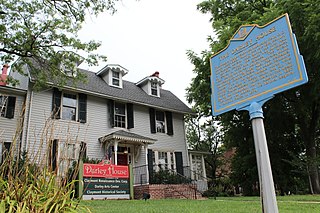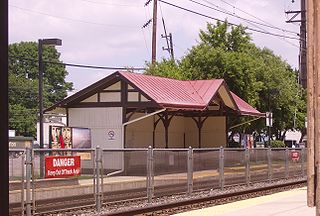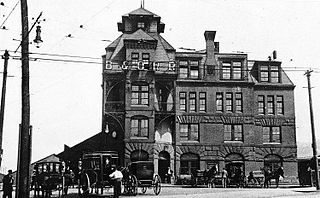
Claymont is a census-designated place (CDP) in New Castle County, Delaware, United States. As of the 2020 U.S. census, the population of Claymont was 9,895.

Frank Heyling Furness was an American architect of the Victorian era. He designed more than 600 buildings, most in the Philadelphia area, and is remembered for his diverse, muscular, often inordinately scaled buildings, and for his influence on the Chicago-based architect Louis Sullivan. Furness also received a Medal of Honor for bravery during the Civil War.

The Maryland Area Rail Commuter (MARC) is a commuter rail system in the Washington–Baltimore area. MARC is administered by the Maryland Transit Administration (MTA) and operated under contract by Alstom and Amtrak on track owned by CSX Transportation (CSXT) and Amtrak. In 2023, the system had a ridership of 3,860,600, or about 13,900 per weekday as of the third quarter of 2024, less than pre-COVID-19 pandemic weekday ridership of 40,000.

Wilmington station, also known as the Joseph R. Biden, Jr., Railroad Station, is a passenger rail station in Wilmington, Delaware. It serves nine Amtrak train routes and is part of the Northeast Corridor. It also serves SEPTA Regional Rail commuter trains on the Wilmington/Newark Line as well as DART First State local buses and Greyhound Lines intercity buses.

The Philadelphia, Wilmington and Baltimore Railroad (PW&B) was an American railroad that operated independently from 1836 to 1881. Headquartered in Philadelphia, it was greatly enlarged in 1838 by the merger of four state-chartered railroads in three Mid-Atlantic states to create a single line between Philadelphia and Baltimore.
The Baltimore and Philadelphia Railroad was a railroad line built by the Baltimore and Ohio Railroad (B&O) from Philadelphia, Pennsylvania, to the Maryland-Delaware state line, where it connected with the B&O's Philadelphia Branch to reach Baltimore, Maryland. It was built in the 1880s after the B&O lost access to its previous route to Philadelphia, the Philadelphia, Wilmington and Baltimore Railroad (PW&B). The cost of building the new route, especially the Howard Street Tunnel on the connecting Baltimore Belt Line, led to the B&O's first bankruptcy. Today, the line is used by CSX Transportation for freight trains.

The Wilmington and Western Railroad is a freight and heritage railroad in northern Delaware, operating over a former Baltimore and Ohio Railroad (B&O) branch line between Wilmington and Hockessin. The 10.2-mile (16.4 km) railroad operates both steam and diesel locomotives. It was added to the National Register of Historic Places as a national historic district in 1980. Wilmington & Western serves one customer for revenue service, and interchanges with CSX Transportation at Landenberg Junction, Delaware

Broad Street Station at Broad and Market streets in Philadelphia was the primary passenger terminal for the Pennsylvania Railroad (PRR) in the city from December 1881 until the 1950s. Located directly west of Philadelphia City Hall, the site is now occupied by the northwest section of Dilworth Park and the office towers of Penn Center.

Morton station, also known as Morton–Rutledge station, is a SEPTA Regional Rail station in Morton, Pennsylvania. Located at Yale and Morton Avenues, it serves the Media/Wawa Line. While the south, inbound platform of the station is in Morton Borough, the north, outbound side is in Springfield Township. Both dollar-a-day and permit parking are available. In 2013, this station saw 720 boardings and 657 alightings on an average weekday.

Philadelphia's Baltimore and Ohio Railroad station – also known as the B & O station or Chestnut Street station – was the main passenger station for the Baltimore and Ohio Railroad in Philadelphia, Pennsylvania. Designed by architect Frank Furness in 1886, it stood at 24th Street and the Chestnut Street Bridge from 1888 to 1963.

The Harrisburg Subdivision is a railroad line owned by CSX Transportation in Pennsylvania. The line is located in Philadelphia, and connects Greenwich Yard and the Philadelphia Subdivision with the Trenton Subdivision along a former Pennsylvania Railroad line. Much of the Harrisburg Subdivision is the High Line' or West Philadelphia Elevated along 31st Street over the 30th Street Station area.

The Philadelphia Subdivision is a railroad line owned and operated by CSX Transportation in the U.S. states of Pennsylvania, Delaware, and Maryland. The line runs from Philadelphia, Pennsylvania, southwest to Baltimore, Maryland, along a former Baltimore and Ohio Railroad (B&O) line.
The Shellpot Branch is a former Pennsylvania Railroad/Penn Central through-freight railroad owned and operated by Norfolk Southern since its acquisition, along with CSX Transportation, of Conrail in 1999. The branch allows Norfolk Southern, since the opening of a new bridge in 2001, to bypass the city of Wilmington, Delaware and allows direct access to both the Port of Wilmington and the New Castle Secondary, which connects to the Delmarva Subdivision of the Delmarva Central Railroad that runs to Central Delaware, Maryland, and Virginia's Eastern Shore. Both ends of the branch connect with Amtrak's Northeast Corridor and, like all of the PRR's through-freight lines, was electrified from 1935 until the Conrail era. The line was originally built doubly tracked, but was subsequently converted to single track.

WWTX is a commercial AM radio station licensed to Wilmington, Delaware. It airs a sports radio format, with most programming from Fox Sports Radio. The studios are on McKee Road in Dover.

The Marylander was a Baltimore and Ohio Railroad (B&O) afternoon passenger train between New York City and Washington, D.C., operated by the B&O in partnership with the Reading Railroad and the Central Railroad of New Jersey between Jersey City, New Jersey, and Washington, D.C.. Other intermediate cities served were Philadelphia, Wilmington, Delaware, and Baltimore, Maryland. The Marylander's origin can be traced back to the late 1890s, when the B&O began its famed Royal Blue Line service between New York and Washington. Operating as #524 northbound and #525 southbound, the trains were called the New York Express and the Washington Express, respectively, in the 1910s and 1920s. The Marylander and its predecessors offered a high level of passenger amenities, such as parlor cars with private drawing rooms, full dining car service, deluxe lounge cars, and onboard radio and telephone service. The Marylander made history in 1948 when it was the first moving train to offer onboard television reception. It was one of B&O's faster trains on the route, maintaining a four-hour schedule until its discontinuation in October 1956 due to declining patronage.
HOOK Tower is a closed interlocking tower on the Pennsylvania Railroad in Marcus Hook, Pennsylvania.

Aberdeen station is a former Baltimore and Ohio Railroad (B&O) station in Aberdeen, Maryland. The station was designed by architect Frank Furness, who designed some 40 stations for the B&O in Delaware, Maryland, and Pennsylvania. The station has deteriorated in condition mightily since B&O ended service in 1955, and was almost torn down in 2003. An eleventh hour agreement was made by CSX and the Historical Society of Harford County to save the building. The station was transferred from the Historical Society of Harford County to the Aberdeen Historical Museum in 2016.
Landenberg Junction is a railroad junction in Elsmere, New Castle County, Delaware.

B&O Railroad Depot was one of several railroad stations in the city of Pittsburgh, Pennsylvania during the late 19th and early 20th century. The station was built in 1887, 16 years after the B&O Railroad opened its first railroad line into Pittsburgh. The station was built next to the Monongahela River. B&O railroad trains also used the Pittsburgh & Lake Erie Railroad Station for services that continued westward towards Chicago via the Pittsburgh & Lake Erie Railroad. In 1955 the station was demolished to make room for an interstate highway and remaining services were transferred to Grant Street Station. The building was designed by Frank Furness who also constructed the B&O Railroad's Philadelphia station.
The Wilmington and Northern Railroad is a railway company that once owned a line from Reading, Pennsylvania to Wilmington, Delaware. The original main line from Wilmington to Birdsboro, Pennsylvania was built between 1869 and 1871 by its predecessor, the Wilmington and Reading Railroad. An extension from Birdsboro to High's Junction was completed in 1874. There the Wilmington and Reading connected with the Berks County Railroad and ran over its tracks to Reading. The Berks County Railroad was foreclosed on at the end of 1874 and reorganized as the Reading and Lehigh Railroad, under the control of the Philadelphia and Reading Rail Road. The Wilmington and Reading also experienced financial difficulties and was itself foreclosed on in 1876. It was reorganized in 1877 as the Wilmington and Northern. After the reorganization, the railroad was closely affiliated with the Reading, but retained its own organization and officers until 1898. In that year, the Reading bought a majority of the company's stock and incorporated it into its own system. The main line from Birdsboro to Wilmington became the Wilmington and Northern Branch, while the extension above Birdsboro was incorporated into the Reading Belt Line. The Wilmington and Northern continued to exist as a paper railroad within the Reading system. The portion of the Wilmington and Northern north of Modena, Pennsylvania was sold to Conrail at its formation in 1976. The line south of Modena was retained by the Wilmington and Northern, which leased and then sold it piecemeal to other railroads between 1981 and 2005. As of 2021, the Wilmington and Northern still survived as a subsidiary of Reading International, Inc.















